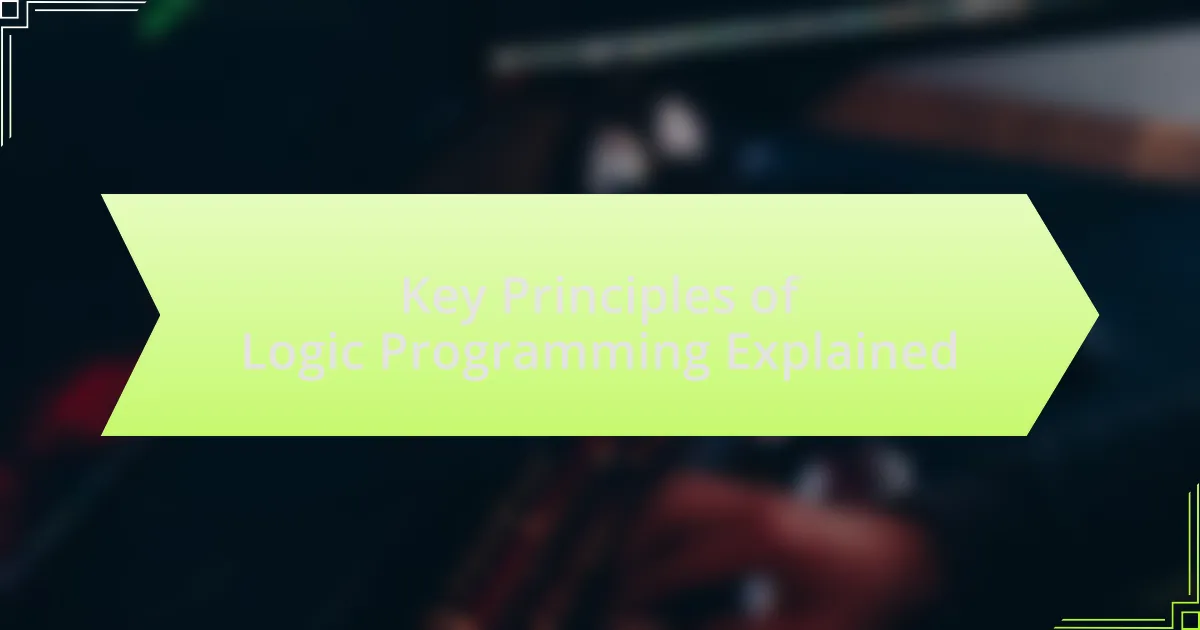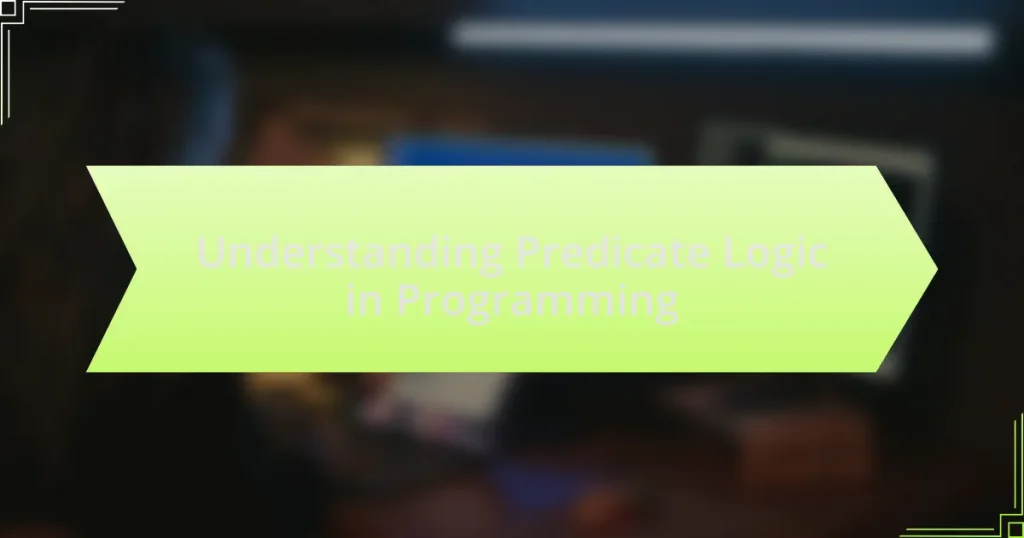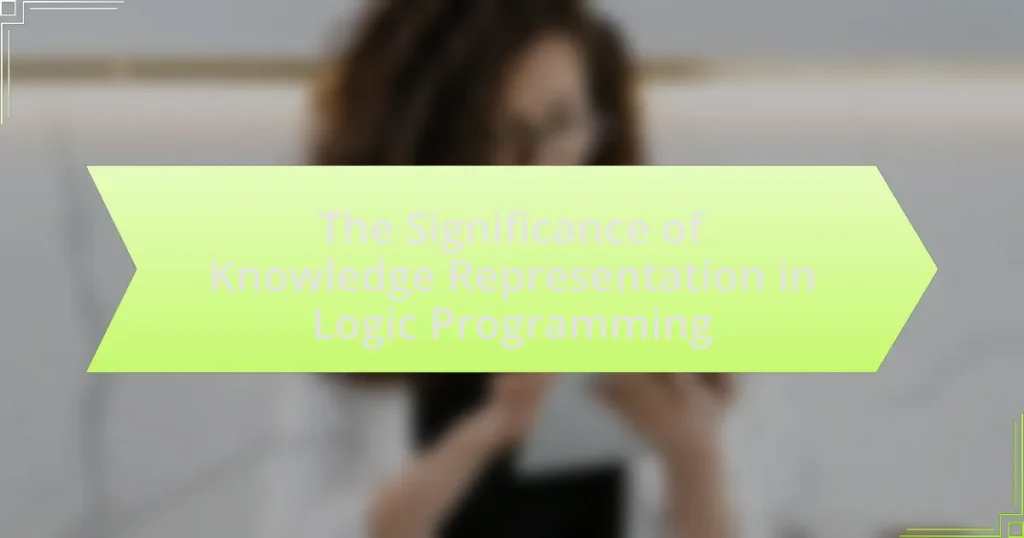The article focuses on the key principles of logic programming, emphasizing its foundational concepts such as declarative programming, facts, rules, and the resolution principle. It distinguishes logic programming from other paradigms by highlighting its unique approach to problem-solving through formal logic and automated reasoning. The article also explores the roles of facts and rules, the inference process, and various methods of inference, including backtracking. Additionally, it discusses the applications of logic programming in fields like artificial intelligence and database management, while addressing the challenges and limitations faced in this programming paradigm.
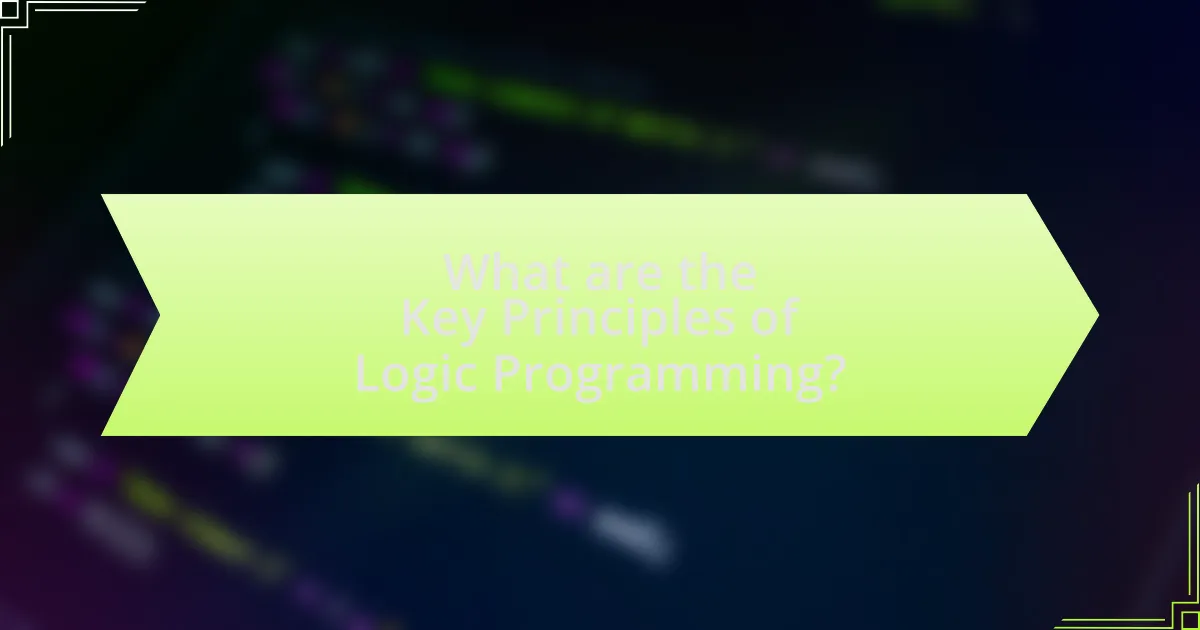
What are the Key Principles of Logic Programming?
The key principles of logic programming include declarative programming, the use of facts and rules, and the resolution principle. Declarative programming allows developers to express the logic of a computation without detailing its control flow. In logic programming, facts represent known information, while rules define relationships and infer new information from existing facts. The resolution principle is a fundamental inference rule used to derive conclusions from premises, enabling automated reasoning. These principles are foundational in languages like Prolog, which exemplify logic programming by allowing users to define problems in terms of relations and queries.
How does Logic Programming differ from other programming paradigms?
Logic programming differs from other programming paradigms primarily in its approach to problem-solving, which is based on formal logic rather than procedural or object-oriented methods. In logic programming, programs are expressed as a set of facts and rules, and computation is performed through logical inference, allowing the programmer to specify what the solution should satisfy rather than how to compute it. This contrasts with imperative programming, where the focus is on a sequence of commands to achieve a result, and with object-oriented programming, which centers around the manipulation of objects and their interactions. The foundational language for logic programming, Prolog, exemplifies this paradigm by allowing users to define relationships and query them, showcasing a declarative style that emphasizes the “what” over the “how.”
What are the fundamental concepts that define Logic Programming?
Logic programming is fundamentally defined by the concepts of facts, rules, and queries. Facts represent basic assertions about the world, rules define relationships and infer new information based on existing facts, and queries allow users to retrieve information or check the validity of statements. These components work together within a logical framework, enabling automated reasoning and problem-solving. The validity of this definition is supported by the foundational work of researchers like Robert Kowalski, who emphasized the importance of these elements in his 1979 paper “Logic for Problem Solving,” establishing logic programming as a distinct paradigm in computer science.
Why is declarative programming significant in Logic Programming?
Declarative programming is significant in Logic Programming because it allows programmers to express the logic of a computation without detailing its control flow. This paradigm emphasizes what the program should accomplish rather than how to achieve it, which aligns with the foundational principles of Logic Programming that focus on formal logic and mathematical reasoning. For instance, in Prolog, a prominent Logic Programming language, developers define facts and rules, and the system automatically determines how to derive conclusions, showcasing the efficiency and clarity that declarative programming brings to problem-solving.
What role do facts and rules play in Logic Programming?
Facts and rules are fundamental components of Logic Programming, serving as the building blocks for knowledge representation and inference. Facts represent basic assertions about the world, while rules define relationships and logical implications between those facts. For instance, in Prolog, a fact might state “Bird(tweety).” and a rule could express “CanFly(X) :- Bird(X).” This structure allows the program to derive new information by applying rules to existing facts, enabling automated reasoning and problem-solving. The effectiveness of Logic Programming relies on this interplay, as it allows for the systematic exploration of logical relationships and the generation of conclusions based on the provided knowledge base.
How are facts represented in Logic Programming?
Facts in Logic Programming are represented as atomic sentences or predicates that express basic assertions about the world. Each fact typically consists of a predicate symbol followed by a list of arguments, which can be constants, variables, or functions. For example, the fact “loves(john, mary)” indicates that John loves Mary, where “loves” is the predicate and “john” and “mary” are the arguments. This representation allows for logical inference and reasoning, as facts can be used in conjunction with rules to derive new information. The use of predicates and arguments in this structured format is foundational to the functioning of logic programming languages like Prolog.
What types of rules are commonly used in Logic Programming?
In Logic Programming, the commonly used types of rules are facts, rules, and queries. Facts represent basic assertions about the world, such as “Birds are animals.” Rules define relationships and conditions, typically in the form of implications, such as “If X is a bird, then X can fly.” Queries are used to ask questions about the knowledge base, allowing for the retrieval of information based on the defined facts and rules. These components form the foundation of Logic Programming, enabling reasoning and inference within a logical framework.
How does the inference process work in Logic Programming?
The inference process in Logic Programming operates through a systematic method of deriving conclusions from a set of premises using rules of logic. This process typically involves the use of a resolution algorithm, which identifies contradictions in the knowledge base and derives new information by applying logical rules to existing facts and rules.
In Logic Programming, facts are represented as logical statements, and rules define how these facts can be combined or manipulated. The inference engine evaluates these statements to determine if a query can be satisfied based on the available information. For example, if a rule states that “if A is true, then B is true,” and A is confirmed as true, the inference engine can conclude that B must also be true.
The validity of this inference process is supported by the completeness and soundness of logical systems, which ensure that all true statements can be derived and that only true statements can be derived from true premises. This foundational principle is crucial for the reliability of conclusions drawn in Logic Programming.
What are the different methods of inference in Logic Programming?
The different methods of inference in Logic Programming include resolution, unification, and backward chaining. Resolution is a rule of inference that derives a contradiction from a set of clauses, allowing for the derivation of new clauses. Unification is the process of making different logical expressions identical by finding a substitution for their variables. Backward chaining is a goal-driven approach that starts with a goal and works backward to find supporting facts or rules that lead to that goal. These methods are foundational in Logic Programming, enabling automated reasoning and problem-solving.
How does backtracking contribute to the inference process?
Backtracking significantly enhances the inference process by systematically exploring potential solutions and retracting steps when a contradiction is encountered. This method allows logic programming systems to efficiently navigate complex problem spaces by eliminating paths that do not lead to valid conclusions, thereby optimizing the search for correct answers. For instance, in Prolog, backtracking enables the engine to revert to previous states and try alternative rules or facts, ensuring that all possible solutions are considered without redundant computations. This approach not only improves the accuracy of inferences but also reduces the time complexity associated with finding solutions in logical frameworks.
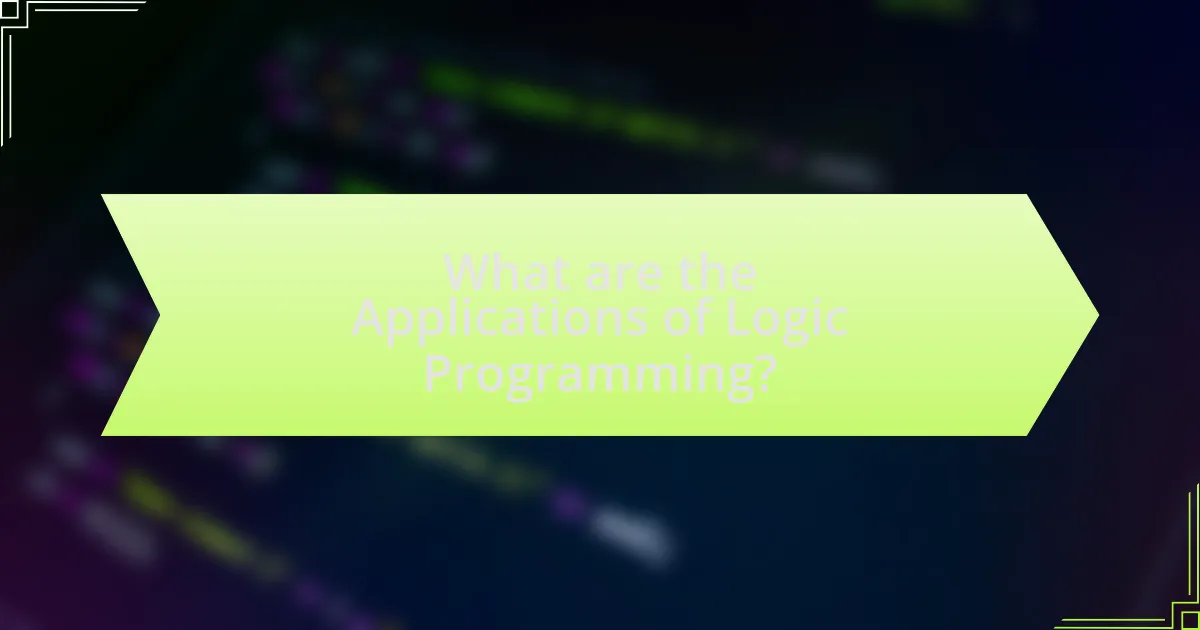
What are the Applications of Logic Programming?
Logic programming has diverse applications across various fields, including artificial intelligence, natural language processing, and database management. In artificial intelligence, logic programming is utilized for knowledge representation and reasoning, enabling systems to infer new information from existing data. In natural language processing, it aids in parsing and understanding human languages by defining grammatical rules and relationships. Additionally, in database management, logic programming facilitates query processing and data retrieval through declarative queries, allowing for efficient data manipulation. These applications demonstrate the versatility and effectiveness of logic programming in solving complex problems across multiple domains.
In which domains is Logic Programming most effectively utilized?
Logic Programming is most effectively utilized in domains such as artificial intelligence, natural language processing, and database management. In artificial intelligence, it facilitates knowledge representation and reasoning, enabling systems to infer new information from existing data. In natural language processing, Logic Programming aids in understanding and generating human language through formal semantics. In database management, it supports query languages like Prolog, allowing for complex data retrieval and manipulation. These applications demonstrate the versatility and power of Logic Programming in solving complex problems across various fields.
How does Logic Programming enhance artificial intelligence applications?
Logic programming enhances artificial intelligence applications by providing a formal framework for knowledge representation and automated reasoning. This paradigm allows AI systems to express complex relationships and rules in a declarative manner, facilitating the development of intelligent agents that can infer new information from existing knowledge. For instance, Prolog, a prominent logic programming language, enables the implementation of expert systems that can solve problems through logical deduction, as evidenced by its use in medical diagnosis and natural language processing. The ability to handle uncertainty and perform backtracking search further strengthens the effectiveness of logic programming in AI, making it a crucial component in the advancement of intelligent systems.
What role does Logic Programming play in database management systems?
Logic programming plays a crucial role in database management systems by enabling declarative querying and reasoning about data. It allows users to express queries in a logical form, which the system can then interpret and execute, facilitating complex data retrieval and manipulation. For instance, languages like Prolog utilize logic programming principles to enable users to define relationships and rules, making it easier to derive conclusions from the data stored in databases. This approach enhances the expressiveness and flexibility of database queries, allowing for more sophisticated data interactions compared to traditional procedural query languages.
What are the advantages of using Logic Programming?
Logic programming offers several advantages, including declarative problem-solving, ease of reasoning, and automatic backtracking. Declarative problem-solving allows programmers to focus on what the program should accomplish rather than how to achieve it, which simplifies the coding process. The ease of reasoning stems from the logical foundations of the programming paradigm, enabling clearer understanding and verification of program behavior. Automatic backtracking enhances efficiency by allowing the system to explore multiple potential solutions without requiring explicit instructions from the programmer. These advantages contribute to the effectiveness and efficiency of logic programming in various applications, such as artificial intelligence and complex problem-solving scenarios.
How does Logic Programming improve problem-solving capabilities?
Logic programming enhances problem-solving capabilities by allowing for declarative problem representation and automated reasoning. This programming paradigm enables users to express problems in terms of relations and rules, which can be processed by logic solvers to derive solutions efficiently. For instance, Prolog, a prominent logic programming language, uses a resolution-based inference mechanism that systematically explores possible solutions, significantly reducing the search space compared to imperative programming approaches. Studies have shown that logic programming can solve complex problems in areas such as artificial intelligence and database querying, demonstrating its effectiveness in optimizing problem-solving processes.
What are the efficiency benefits of Logic Programming?
Logic programming offers significant efficiency benefits, primarily through its declarative nature, which allows for concise problem representation and automatic inference. This approach reduces the need for extensive procedural coding, enabling faster development and easier maintenance. Additionally, logic programming systems utilize powerful backtracking and unification techniques, which optimize search processes and enhance performance in solving complex problems. For instance, Prolog, a well-known logic programming language, can efficiently handle large datasets and complex queries due to its built-in mechanisms for logical reasoning and pattern matching. These characteristics collectively contribute to improved efficiency in both development time and computational resource usage.
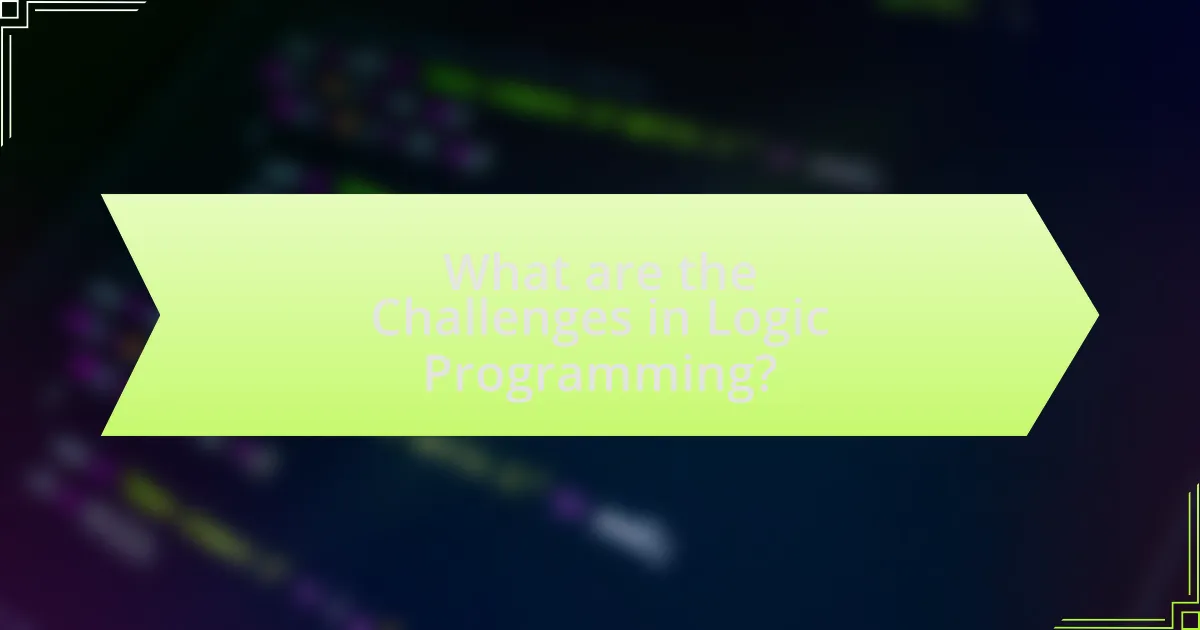
What are the Challenges in Logic Programming?
The challenges in logic programming include issues such as efficiency, expressiveness, and debugging complexity. Efficiency is a significant concern because logic programs can suffer from performance issues due to the inherent backtracking and search mechanisms used in resolution. Expressiveness can be limited, as certain problems may not be easily represented in a logic programming paradigm, making it difficult to model complex systems. Additionally, debugging logic programs can be challenging due to the non-linear execution flow and the difficulty in tracing logical inferences, which complicates the identification of errors. These challenges highlight the need for ongoing research and development to enhance the practicality and usability of logic programming in various applications.
What limitations does Logic Programming face?
Logic programming faces several limitations, including inefficiency in handling large datasets and difficulty in expressing certain types of problems. The inherent search mechanism in logic programming can lead to performance issues, particularly when the search space is vast, as seen in Prolog implementations where backtracking can become computationally expensive. Additionally, logic programming struggles with side effects and state changes, making it less suitable for applications requiring mutable state, such as real-time systems. These limitations are documented in various studies, including “The Logic Programming Paradigm” by Robert Kowalski, which highlights the challenges of scalability and expressiveness in practical applications.
How does the complexity of problems affect Logic Programming?
The complexity of problems significantly impacts Logic Programming by influencing the efficiency and feasibility of problem-solving. As problems increase in complexity, the search space for solutions expands, which can lead to longer computation times and higher resource consumption. For instance, NP-complete problems, which are known for their computational difficulty, can render traditional Logic Programming techniques inefficient, as they may require exponential time to find solutions. This necessitates the development of more advanced algorithms and heuristics to manage complexity effectively, such as constraint logic programming, which helps to prune the search space and optimize performance.
What are the common pitfalls when using Logic Programming?
Common pitfalls when using Logic Programming include inefficiency in execution, difficulty in debugging, and challenges in expressing certain types of problems. Inefficiency arises because logic programs can lead to excessive backtracking, which slows down computation. Debugging is complicated due to the non-procedural nature of logic programming, making it hard to trace the flow of execution. Additionally, some problems, particularly those requiring complex state changes or side effects, are difficult to represent in a purely declarative manner, limiting the applicability of logic programming in certain domains.
How can one overcome challenges in Logic Programming?
To overcome challenges in Logic Programming, one should focus on mastering the foundational concepts and techniques, such as understanding predicate logic, recursion, and backtracking. By gaining a solid grasp of these principles, programmers can effectively troubleshoot and optimize their code. For instance, familiarity with Prolog’s syntax and semantics allows for better debugging and efficient problem-solving. Additionally, utilizing resources like online tutorials, forums, and academic papers can provide practical insights and solutions to common issues faced in Logic Programming. Engaging with the community through platforms like Stack Overflow can also facilitate knowledge sharing and support.
What best practices should be followed in Logic Programming?
Best practices in Logic Programming include writing clear and concise rules, using meaningful variable names, and ensuring that predicates are well-defined and modular. Clear and concise rules enhance readability and maintainability, which is crucial for debugging and collaboration. Meaningful variable names improve code comprehension, allowing others to understand the logic without extensive comments. Well-defined and modular predicates facilitate reuse and testing, as they encapsulate specific functionalities. These practices align with established programming principles, such as the DRY (Don’t Repeat Yourself) principle, which emphasizes reducing redundancy to improve code quality.
How can debugging be effectively managed in Logic Programming?
Debugging in Logic Programming can be effectively managed through systematic techniques such as trace debugging, constraint debugging, and using debugging tools specifically designed for logic languages. Trace debugging allows developers to follow the execution of a program step-by-step, identifying where the logic diverges from expected outcomes. Constraint debugging focuses on isolating and resolving issues related to constraints that may not be satisfied, which is crucial in logic-based systems. Additionally, tools like SWI-Prolog’s built-in debugger provide functionalities such as breakpoints and variable inspection, enhancing the debugging process. These methods are validated by their widespread use in academic and practical applications, demonstrating their effectiveness in identifying and resolving logical errors.
What are some practical tips for beginners in Logic Programming?
Beginners in Logic Programming should start by understanding the fundamental concepts such as predicates, facts, and rules. Familiarizing oneself with these elements is crucial because they form the basis of logic programming languages like Prolog. Additionally, practicing with simple problems helps solidify understanding; for example, solving basic logical puzzles can enhance problem-solving skills. Utilizing online resources, such as tutorials and forums, provides valuable support and community engagement, which is beneficial for learning. Lastly, experimenting with code and debugging is essential, as it allows beginners to grasp how logic programming operates in practice, reinforcing their learning through hands-on experience.
How can one start learning Logic Programming effectively?
To start learning Logic Programming effectively, one should begin with foundational concepts such as predicates, clauses, and inference rules. Engaging with resources like textbooks, online courses, and tutorials specifically focused on languages like Prolog can provide structured learning. For instance, “Programming in Prolog” by Clocksin and Mellish is a widely recommended textbook that covers essential topics and practical examples. Additionally, practicing coding exercises on platforms like Codecademy or using Prolog interpreters can reinforce understanding through hands-on experience.
What resources are available for mastering Logic Programming?
To master Logic Programming, several resources are available, including textbooks, online courses, and programming communities. Notable textbooks include “Programming in Prolog” by Clocksin and Mellish, which provides foundational knowledge and practical exercises. Online platforms like Coursera and edX offer courses such as “Introduction to Logic Programming” that cover essential concepts and applications. Additionally, programming communities like Stack Overflow and GitHub provide forums for discussion and collaboration, allowing learners to engage with experienced programmers and access a wealth of shared knowledge and code examples. These resources collectively support a comprehensive understanding of Logic Programming principles and practices.
